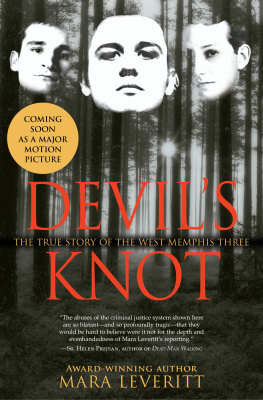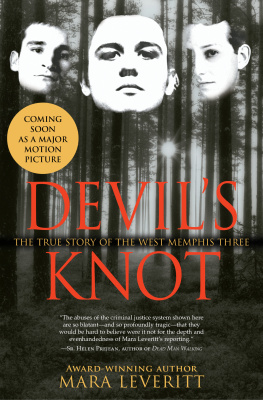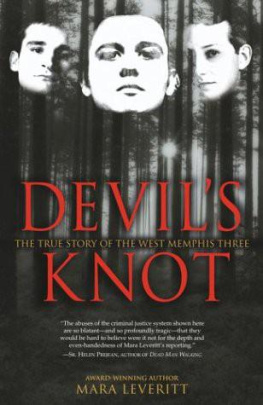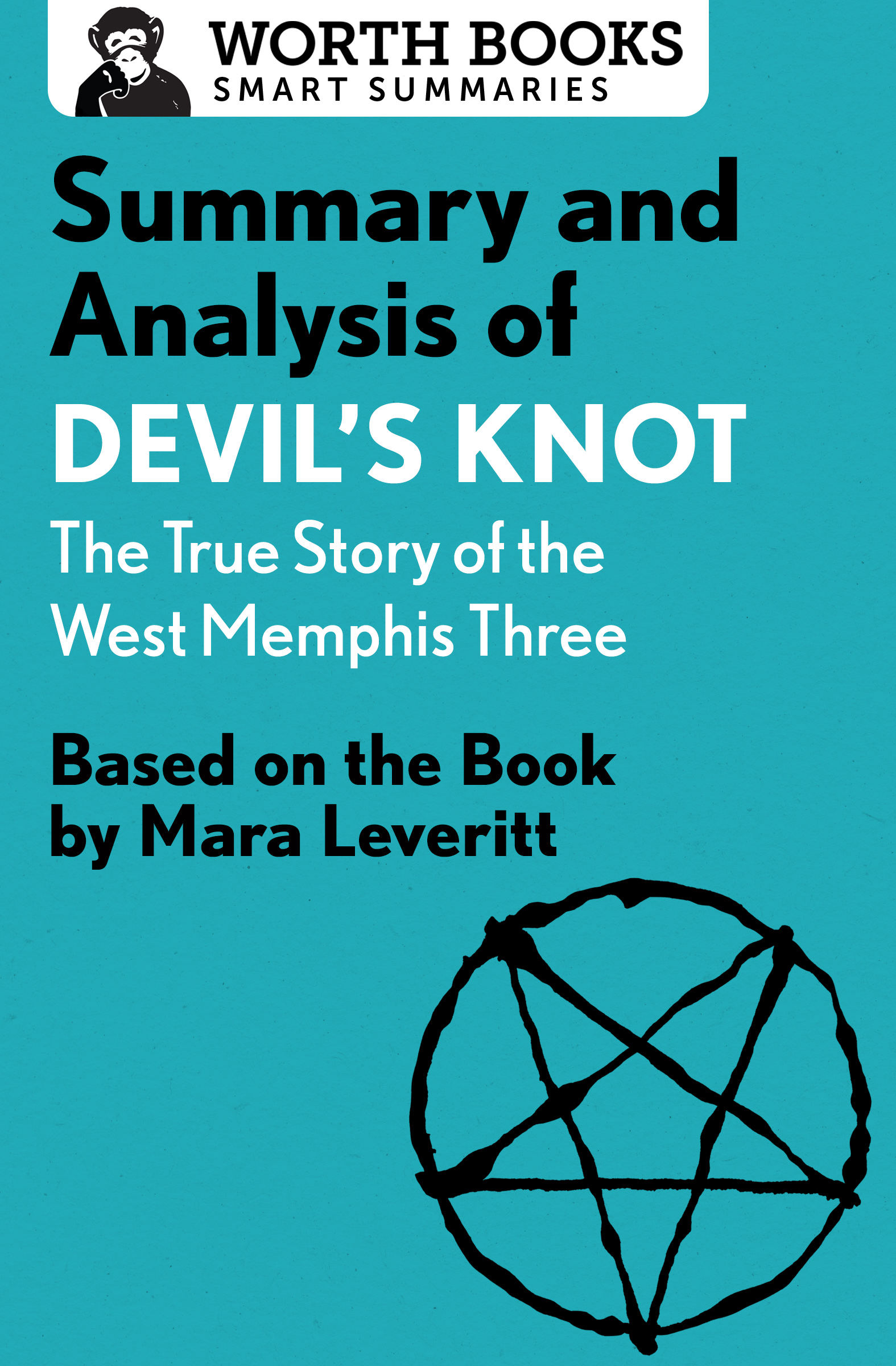Summary and Analysis of
Devils Knot
The True Story of the West Memphis Three
Based on the Book by Mara Leveritt

Contents
Context
Originally published in 2002, Devils Knot: The True Story of the West Memphis Three is part of a mass movement expressing outrage over what many perceived to be the wrongful imprisonment of three young men in Arkansas, seemingly railroaded into conviction for the horrifically sadistic 1993 murder of three young boys. The 1996 movie Paradise Lost: The Child Murders at Robin Hood Hills and its two sequels played a major role in raising public awareness of the plight of the West Memphis Three, and over the years, celebrity supporters such as Johnny Depp and Eddie Vedder further publicized their cause.
At the time of the books first publication in 2002, the West MemphisThree were still incarcerated, with Damien Echols facing the death penalty, andJason Baldwin and Jessie Misskelley Jr. serving life sentences. In 2011, they werereleased from prison following a bizarre plea deal in which the state effectivelyrefused to admit it had been wrong. Of course, it is impossible to quantify theextent to which Devils Knot influenced the Arkansascourt suddenly relenting. But certainly Mara Leveritt was a significant voice amongthe chorus of those demanding a reversal of injustice.
Today, the West Memphis Three are free men, but they have not technically been exonerated. And, tragically, they can never get back the years of their lives they spent locked up.
Overview
Mara Leveritts book Devils Knot raises questions about our modern American justice system: How and why, in the absence of compelling evidence, were three young men scapegoated andalmost literallydemonized because of their lifestyle choices?
There is no question that the circumstances that led to the now-infamous West Memphis Three murder trial were particularly horrific: In 1993, three eight-year-old boys were brutally tortured and murdered, and their bodiesbound by their own shoelaceswere thrown into a gully. One of the boys was genitally mutilated. Understandably, the people of their Arkansas town were terrified, and the case gained much sensational attention in the local media.
But, under pressure to solve the case, West Memphis police called out three teenagersDamien Echols, Jason Baldwin, and Jessie Misskelley Jr.on the spurious suspicion that they were part of a satanic cult and that the murders amounted to a ritual sacrifice. These three young men were hardly equipped to fight the legal system. They had grown up in poverty, facing family problems (for instance, Jason discovered his mother after she attempted suicide and called 911 to save her) and, at least in Damiens case, psychological issues. Jessie, who confessed to the murders under intense police questioning, had an IQ of 80 and the equivalent of a third-grade education.
Leveritt convincingly argues that authorities singled out these boys, particularly Damien, because they were different. Media coverage of the case repeated and reinforced outlandish local rumors about the suspects being devil worshippers who engaged in bloody rituals, leading to the widespread perception of the crime (which took place on the night of a full moon) as being a cold-blooded act of human sacrifice. But there was no evidence to substantiate that these allegations were anything more than hearsay. In fact, there was essentially no physical evidence to place the West Memphis Three at the scene or tie them to the crime.
Notwithstanding the many eyebrow-raising breaches in protocol committed in the course of the West Memphis polices investigation, and the glaringly inconsistent and improbable arguments brought forth by prosecutors, all three were convicted. Damien was given the death penalty, and Jason and Jessie life sentences. Upon appeal, the conviction was upheld. Their case received national attention and public sympathy for their plight, thanks in large part to the HBO documentary Paradise Lost and its two sequels.
But despite the outcry, the West Memphis Three were not released from prison until a surprise plea deal ended their sentences in 2011nine years after the original publication date of Devils Knot, and 18 years after the crimes were committed. At that point, Damien, Jason, and Jessie had spent half their lives behind bars.
Summary
Prologue
In modern-day America, we like to believe that we live in a far more enlightened society, with a far more rational and scientific justice system, than the Puritans who burned supposed witches at the stake.
Yet the story of the West Memphis Three raises unsettling questions about how far that justice system has actually come, when teenagers can be tried and sentenced based on how they present themselves.
Need to Know: Mara Leveritts mission is to explore how, at least in this case, the modern American justice system devolved back to the witch hunt modus operandi of colonial times.
Part One: The Investigation
Chapter One: The Murders
West Memphis, Arkansas, is a town with a strip of road where two interstate highways merge and truckers make pit stops. Near that stretch of road is a wooded area known as Robin Hood, where a large manmade ditch collects rainwater. On May 6, 1993, three eight-year-old boys, naked, bound, and bearing marks of hideous torture, were found in a gully there.
The boysChristopher Byers, Michael Moore, and Stevie Branchhad each been reported missing by their parents the previous evening: The three young friends had gone bike riding that night, and the sky was illuminated from the full moons glow. It wasnt until the next morning that Chief Inspector Gary W. Gitchell of the West Memphis police department mounted a concerted search effort.
By afternoon, all three boys naked bodies and their clotheswhich had been tied underwater to sticks stuck in the mudhad been recovered. It was a ghastly sight: Their hands were tied to their feet by their own shoelaces. Their bodies bore horrible wounds, and Christopher had been castrated.
Although Gitchell stayed mum with reporters, the Memphis Commercial Appeal got wind of the gory details via a police scanner. Theories almost immediately sprang up among horrified West Memphis residents that the murders were somehow connected to satanic worship. After days went by without leads, the police seemed receptive to taking these spurious rumors as a valid theory.
Need to Know: On the night of May 5, another police report was filed, stating that a bleeding black man had gone into a restaurant, Bojangles, and used the bathroom, leaving blood smeared on the walls. Reginia Meek, the same cop who had filed reports on Christopher Byers and Michael Moore, took the managers report about the mentally disoriented man from the drive-through, but did not actually go inside. One cant help but wonder whether, if she had checked out that bathroom, the West Memphis Three case would have unfolded differently.
Chapter Two: The West Memphis Police
Members of the West Memphis police department, along with members of the Crittenden County drug task force, were being investigated for possible widespread corruption. Some officers had been taking guns seized as evidence in narcotics busts; one, who was pawning the guns to buy drugs, was found murdered.
Need to Know: John Mark Byers, stepfather of Christopher, was an undercover informant to the countys task force and a drug dealer himself. He was chummy with the authorities and socialized with local officers. When he was convicted of threatening to kill his ex-wife, and later busted on drug charges, the charges were wiped out for reasons unknown.












